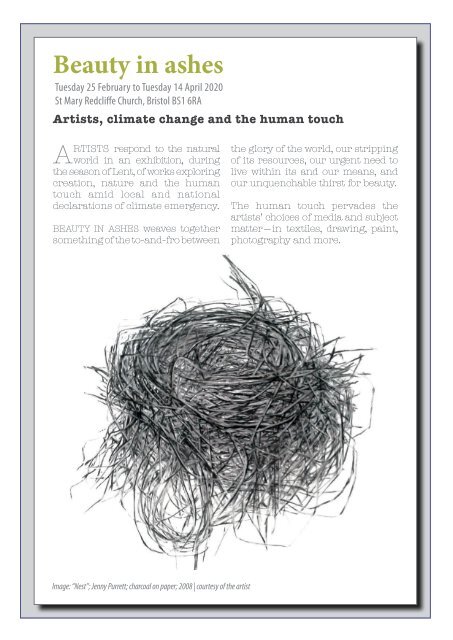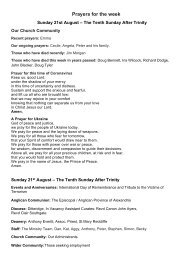St Mary Redcliffe Parish Magazine February/March 2020
Create successful ePaper yourself
Turn your PDF publications into a flip-book with our unique Google optimized e-Paper software.
Beauty in ashes<br />
Tuesday 25 <strong>February</strong> to Tuesday 14 April <strong>2020</strong><br />
<strong>St</strong> <strong>Mary</strong> <strong>Redcliffe</strong> Church, Bristol BS1 6RA<br />
Artists, climate change and the human touch<br />
ARTISTS respond to the natural<br />
world in an exhibition, during<br />
the season of Lent, of works exploring<br />
creation, nature and the human<br />
touch amid local and national<br />
declarations of climate emergency.<br />
BEAUTY IN ASHES weaves together<br />
something of the to-and-fro between<br />
the glory of the world, our stripping<br />
of its resources, our urgent need to<br />
live within its and our means, and<br />
our unquenchable thirst for beauty.<br />
The human touch pervades the<br />
artists’ choices of media and subject<br />
matter — in textiles, drawing, paint,<br />
photography and more.<br />
at church | lent appeal<br />
— ECO BRICKS AND HOW TO MAKE THEM<br />
LIZ HEWITT; LENT ECO TEAM<br />
AN ‘ECO BRICK’ IS A BUILDING BLOCK<br />
made entirely from unrecyclable plastic.<br />
It is created by filling a plastic bottle with<br />
clean, dry plastic until it is packed so tightly it<br />
resembles a traditional brick and then can be used<br />
as a building block. Plastic doesn’t biodegrade,<br />
it photodegrades, meaning that it slowly breaks<br />
down into smaller and smaller pieces. So plastic<br />
is extremely durable, making it ideal as a building<br />
material. Throughout the world Eco bricks are being<br />
used to construct furniture and even buildings,<br />
such as composting toilet blocks, and school<br />
buildings in Guatemala and South Africa. Here in the<br />
UK they are being used, for instance, to construct greenhouses<br />
and children’s playgrounds.<br />
What type of plastic to collect for Eco bricks? Any type of plastic can<br />
be used. Plastic that can’t be recycled is ideal for Eco bricks — that can’t<br />
be scrunched and is firm and crisp to the touch. Examples include biscuit<br />
and sweet wrappers; chocolate trays; greeting card bags; plastic wrapped<br />
around flowers and around clothing (high street and online shopping);<br />
plastic that the council can’t recycle (some coloured plastics), and more.<br />
Image: “Nest”; Jenny Purrett; charcoal on paper; 2008 | courtesy of the artist<br />
However... please recycle plastics if possible — much can be, so check with<br />
your local council to find out what they can take. Please note that some<br />
supermarkets recycle used crisp packets and soft, stretchy types of plastic<br />
bag, or any that can be scrunched into a ball or torn by hand — bags used<br />
for fruit, vegetables, bread and so on; carrier bags; bubble wrap; pet food<br />
packets; coffee packets; clingfilm, and so on. Tesco have 5 stores in Bristol<br />
with recycling points, and Sainsburys, Waitrose and Morrisons will recycle<br />
soft, stretchy plastics in in-store boxes — plus a company called TerraCycle*<br />
offers free recycling to communities of many unrecyclable plastics.<br />
14 15<br />
*see overleaf


















